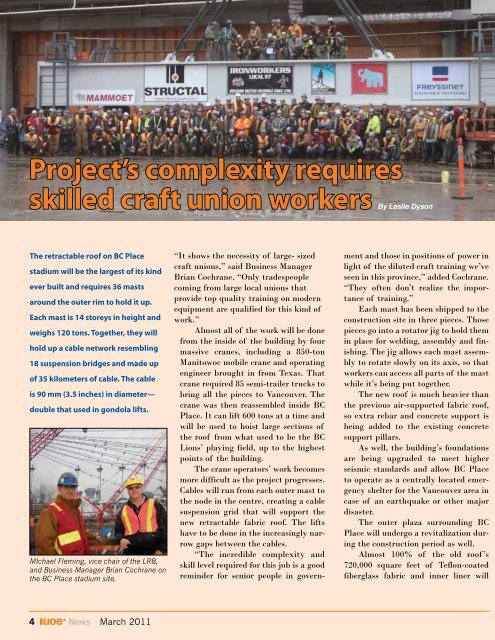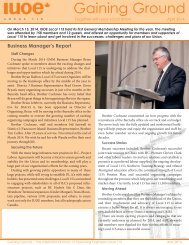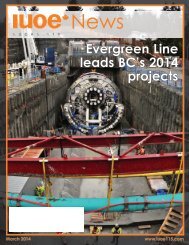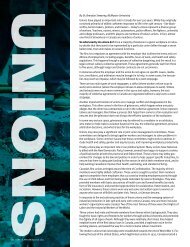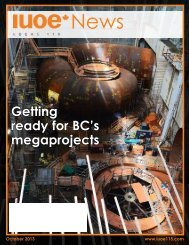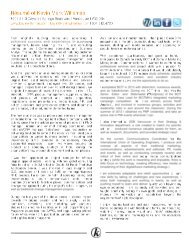IUOE News - Spring 2011
IUOE News - Spring 2011
IUOE News - Spring 2011
You also want an ePaper? Increase the reach of your titles
YUMPU automatically turns print PDFs into web optimized ePapers that Google loves.
Project’s complexity requires<br />
skilled craft union workers By Leslie Dyson<br />
The retractable roof on BC Place<br />
stadium will be the largest of its kind<br />
ever built and requires 36 masts<br />
around the outer rim to hold it up.<br />
Each mast is 14 storeys in height and<br />
weighs 120 tons. Together, they will<br />
hold up a cable network resembling<br />
18 suspension bridges and made up<br />
of 35 kilometers of cable. The cable<br />
is 90 mm (3.5 inches) in diameter—<br />
double that used in gondola lifts.<br />
MIchael Fleming, vice chair of the LRB,<br />
and Business Manager Brian Cochrane on<br />
the BC Place stadium site.<br />
4 <strong>News</strong> March <strong>2011</strong><br />
“It shows the necessity of large- sized<br />
craft unions,” said Business Manager<br />
Brian Cochrane. “Only tradespeople<br />
coming from large local unions that<br />
provide top quality training on modern<br />
equipment are qualified for this kind of<br />
work.”<br />
Almost all of the work will be done<br />
from the inside of the building by four<br />
massive cranes, including a 850-ton<br />
Manitowoc mobile crane and operating<br />
engineer brought in from Texas. That<br />
crane required 85 semi-trailer trucks to<br />
bring all the pieces to Vancouver. The<br />
crane was then reassembled inside BC<br />
Place. It can lift 600 tons at a time and<br />
will be used to hoist large sections of<br />
the roof from what used to be the BC<br />
Lions’ playing field, up to the highest<br />
points of the building.<br />
The crane operators’ work becomes<br />
more difficult as the project progresses.<br />
Cables will run from each outer mast to<br />
the node in the centre, creating a cable<br />
suspension grid that will support the<br />
new retractable fabric roof. The lifts<br />
have to be done in the increasingly narrow<br />
gaps between the cables.<br />
“The incredible complexity and<br />
skill level required for this job is a good<br />
reminder for senior people in govern-<br />
ment and those in positions of power in<br />
light of the diluted craft training we’ve<br />
seen in this province,” added Cochrane.<br />
“They often don’t realize the importance<br />
of training.”<br />
Each mast has been shipped to the<br />
construction site in three pieces. Those<br />
pieces go into a rotator jig to hold them<br />
in place for welding, assembly and finishing.<br />
The jig allows each mast assembly<br />
to rotate slowly on its axis, so that<br />
workers can access all parts of the mast<br />
while it’s being put together.<br />
The new roof is much heavier than<br />
the previous air-supported fabric roof,<br />
so extra rebar and concrete support is<br />
being added to the existing concrete<br />
support pillars.<br />
As well, the building’s foundations<br />
are being upgraded to meet higher<br />
seismic standards and allow BC Place<br />
to operate as a centrally located emergency<br />
shelter for the Vancouver area in<br />
case of an earthquake or other major<br />
disaster.<br />
The outer plaza surrounding BC<br />
Place will undergo a revitalization during<br />
the construction period as well.<br />
Almost 100% of the old roof ’s<br />
720,000 square feet of Teflon-coated<br />
fiberglass fabric and inner liner will


